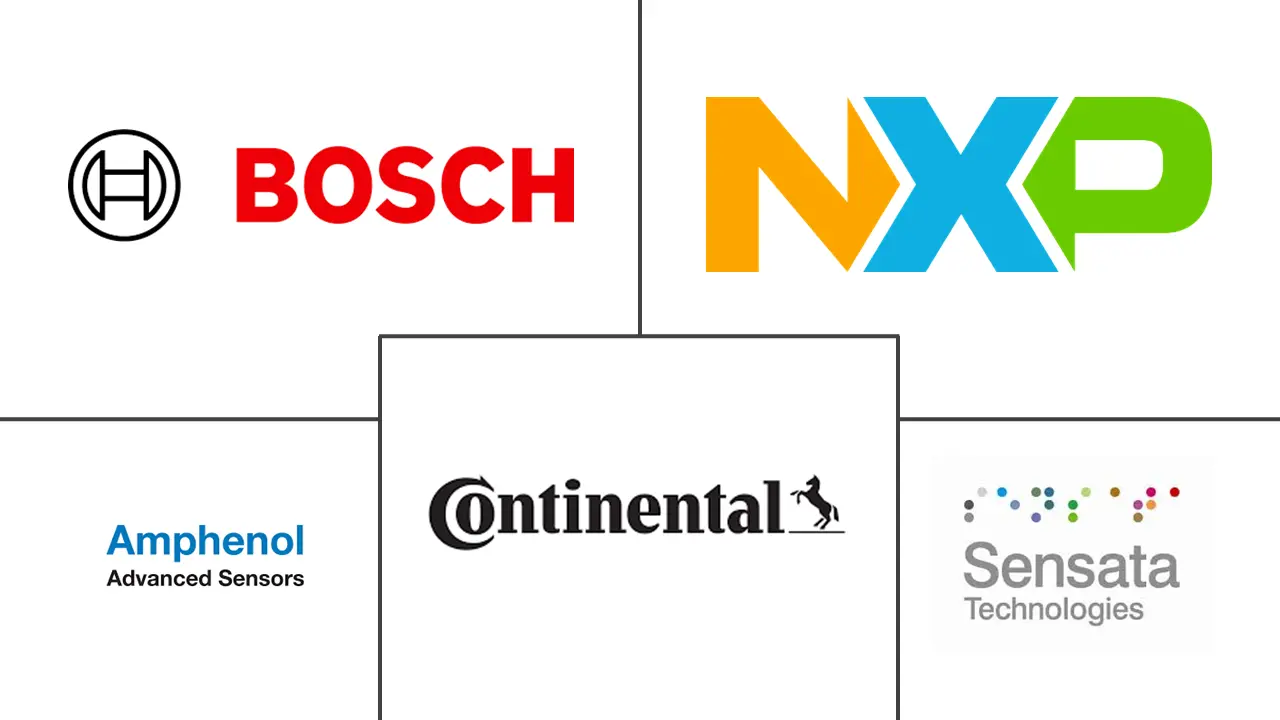Automotive Temperature Sensor Market Size and Share
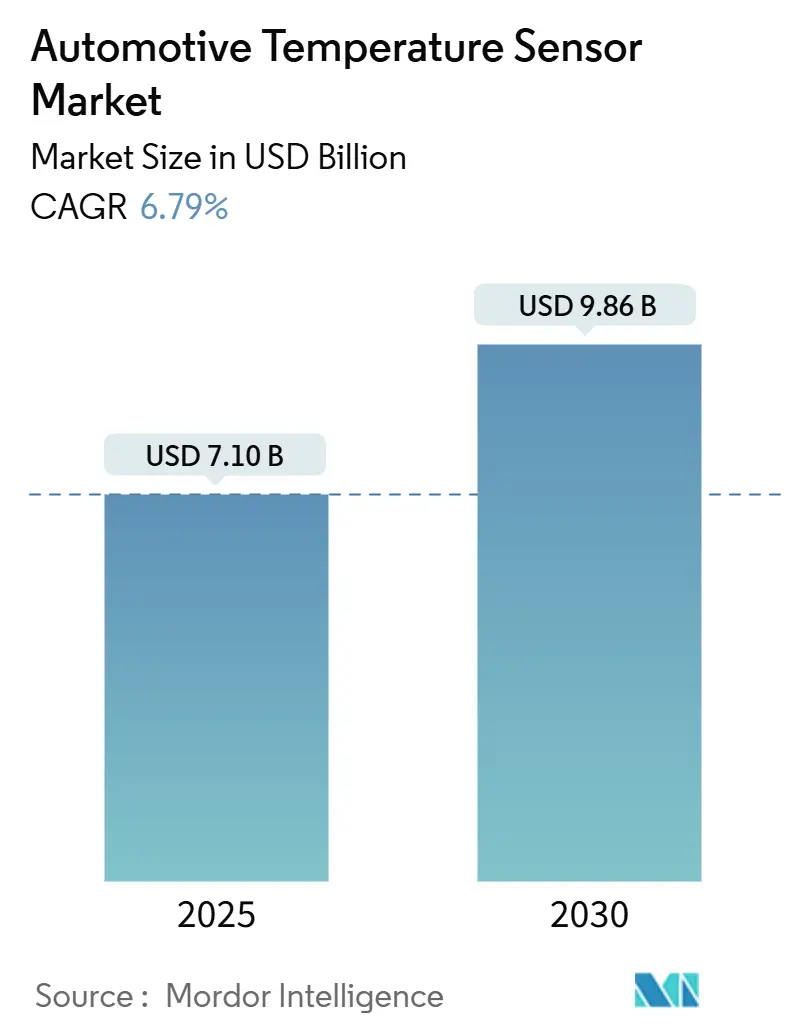
Automotive Temperature Sensor Market Analysis by Mordor Intelligence
The automotive temperature sensor market is valued at USD 7.1 billion in 2025 and is forecast to reach USD 9.86 billion by 2030, advancing at a 6.79% CAGR. Growth is anchored by rapid electrification, with battery-electric vehicles (BEVs) installing close to 150 sensing points per car, nearly triple the requirement in combustion platforms. Zonal electronic architectures are compressing wiring looms and pushing demand for multi-point measurement nodes that can report through automotive Ethernet. High-voltage 800 V drivetrains built around silicon-carbide (SiC) inverters need precision sensors that remain stable above 600 °C, while EU7 and China VI-b regulations widen exhaust temperature monitoring windows as internal-combustion models sunset. Cabin health features in premium trims, solid-state battery pilots, and the migration to wafer-level sensor packaging are catalyzing additional volume in both OEM and service channels.
Key Report Takeaways
- By sensor type, thermistors led with 43% of automotive temperature sensor market share in 2024; semiconductor IC sensors are projected to expand at an 8.8% CAGR through 2030.
- By vehicle type, passenger cars captured 68.5% revenue share in 2024, while BEVs are forecast to grow at a 10.3% CAGR.
- By application, battery & electric drivetrain systems accounted for a 39.2% slice of automotive temperature sensor market size in 2024 and are set to advance at an 11.7% CAGR.
- By sales channel, OEM fitment held 91.4% share of the automotive temperature sensor market size in 2024, whereas the aftermarket is rising at a 6.1% CAGR.
- By geography, Asia-Pacific dominated with 41.6% of automotive temperature sensor market share in 2024; the Middle East is on track to register a 9.2% CAGR to 2030.
Global Automotive Temperature Sensor Market Trends and Insights
Drivers Impact Analysis
| DRIVER | (~) % IMPACT ON CAGR FORECAST | GEOGRAPHIC RELEVANCE | IMPACT TIMELINE |
|---|---|---|---|
| Accelerating Adoption of SiC-based Power Electronics Intensifying Thermal Accuracy Requirements in EV Inverters | +1.9% | North America, Europe, China | Medium term (2-4 years) |
| Rapid Growth of Zonal‐Architecture ECUs Driving Multi-Point Temperature Monitoring | +1.5% | Global, with early adoption in Europe and North America | Medium term (2-4 years) |
| EU7 & China VI-b Emission Norms Mandating Exhaust Gas Temperature Sensors with Wider Operating Range | +1.2% | Europe, China, with spillover to other regions | Short term (≤ 2 years) |
| Thermal Management Imperatives in Solid-State Battery Packs | +0.8% | Global, with concentration in Japan, South Korea, and North America | Long term (≥ 4 years) |
| Rising Demand for Cabin Health Sensors (HVAC Air Quality & Seat Comfort) in Premium Vehicles | +0.6% | Europe, North America, China | Medium term (2-4 years) |
| Semiconductor Packaging Shift to Automotive-Grade Wafer-Level Sensors | +0.4% | Global, with concentration in Asia-Pacific | Medium term (2-4 years) |
| Source: Mordor Intelligence | |||
Accelerating Adoption of SiC-Based Power Electronics Intensifying Thermal Accuracy Requirements in EV Inverters
SiC switches enable drive modules to sustain junction temperatures near 600 °C while boosting conversion efficiency by 30% compared with silicon. Each SiC half-bridge therefore integrates two to three extra temperature sensing points to guard against thermal runaway and to optimise derating curves during 800 V fast charging. Foundry expansions at Onsemi and other suppliers underline how thermal data has become mission-critical for gate-drive calibration and extended inverter warranties.[1]Onsemi, “The Rise of Silicon Carbide in Power Electronics,” microchipusa.com
Rapid Growth of Zonal-Architecture ECUs Driving Multi-Point Temperature Monitoring
Vehicle networks built on zone controllers replace dozens of standalone ECUs, trimming wiring mass by 30% yet raising heat density inside sealed aluminium housings. Designers now distribute small digital sensors on local I3C links so that firmware can balance load, fan speed and redundancy in real time. Early deployments across premium European platforms are demonstrating field reliability that is convincing volume-segment OEMs to transition from 2026 onward.[2]Continental Automotive, “Zone Control Units,” continental-automotive.com
EU7 and China VI-b Emission Norms Mandating Exhaust Gas Sensors with Wider Range
Next-generation compliance hardware needs probes that withstand pulsating exhaust up to 950 °C and survive condensate shocks below -40 °C. Continuous data logging demanded by on-board monitoring systems relies on platinum RTDs, high nickel thermocouples, and increasingly SiC micro-hotplates that offer millisecond response.[3]Arrow Electronics, “Thermistors Boost the Development of New Energy Vehicles,” arrow.com This requirement is lengthening sensor replacement cycles and keeping combustion variants in the revenue mix during the decade’s first half.
Thermal Management Imperatives in Solid-State Battery Packs
Solid-electrolyte cells operate safely inside a tighter 20 °C bandwidth than liquid-ion designs, so modules embed dense strings of NTC beads, thin-film RTDs and quartz MEMS sensors. Laboratory results show phase-change composites paired with internal heaters can maintain pack temperatures for two hours at -15 °C, cutting winter range loss by 40%. As pilot lines scale after 2028, hybrid cooling plates with integrated thermoelectric coolers will receive direct feedback from these high-precision sensors.
Restraints Impact Analysis
| RESTRAINTS | (~) % IMPACT ON CAGR FORECAST | GEOGRAPHIC RELEVANCE | IMPACT TIMELINE |
|---|---|---|---|
| Price-Erosion from Standardization of NTC Thermistors among Tier-1s | -0.7% | Global, with highest impact in Asia-Pacific | Short term (≤ 2 years) |
| Supply-Chain Volatility of High-Purity Nickel and Platinum Used in RTDs | -0.5% | Global, with concentration in Europe and North America | Medium term (2-4 years) |
| Slow Retrofit Rates in Commercial Vehicle Fleets | -0.3% | Global, with highest impact in emerging markets | Long term (≥ 4 years) |
| Cross-Sensitivity and Drift Issues in Low-Cost MEMS Sensors Limiting Aftermarket Adoption | -0.2% | Global | Medium term (2-4 years) |
| Source: Mordor Intelligence | |||
Price-Erosion from Standardisation of NTC Thermistors among Tier-1s
Tier-1 harness builders have harmonised specifications around 1 kΩ to 100 kΩ curves, allowing large volume buys that drive annual price concessions of 3%-5%. Pure-play thermistor vendors are responding by shifting output to higher-value epoxy--coated beads for 250 °C zones or by moving up-market into digital ICs that embed calibration tables to secure margins.
Supply-Chain Volatility of High-Purity Nickel & Platinum Used in RTDs
Geopolitical tightening in ore extraction has seen spot prices swing by double digits. Research into electroless-plated nickel films on ceramic tubes demonstrates stable resistance up to 250 °C without precious metals, signalling a mid-term route to lower-cost exhaust gas sensing once corrosion challenges are resolved.
Segment Analysis
By Sensor Type: Thermistors Hold the Lead, ICs Gain Momentum
Thermistors retained a 43% share of the automotive temperature sensor market in 2024 owing to their low cost and proven reliability in coolant, HVAC and entry-level battery modules. Each BEV already deploys more than 100 NTC elements, and the automotive temperature sensor market size attributable to thermistors is on course to rise steadily even as unit prices drift lower. The firm grip of this legacy technology has forced higher-end vehicles to pair NTCs with linearisation algorithms inside zonal compute hubs to reconcile accuracy gaps.
Semiconductor-based IC sensors are advancing at an 8.8% CAGR through 2030. Their ±0.4 °C accuracy and direct I3C/I^2C output simplify harnessing in confined zones such as in-wheel power electronics, where every millimetre counts. As system designers phase out bulky compensation tables, the automotive temperature sensor market benefits from simultaneous gains in performance and bill-of-materials efficiency. RTDs continue serving precision exhaust feedback loops despite metal volatility, while thermocouples stay embedded in turbo housings that exceed 900 °C.
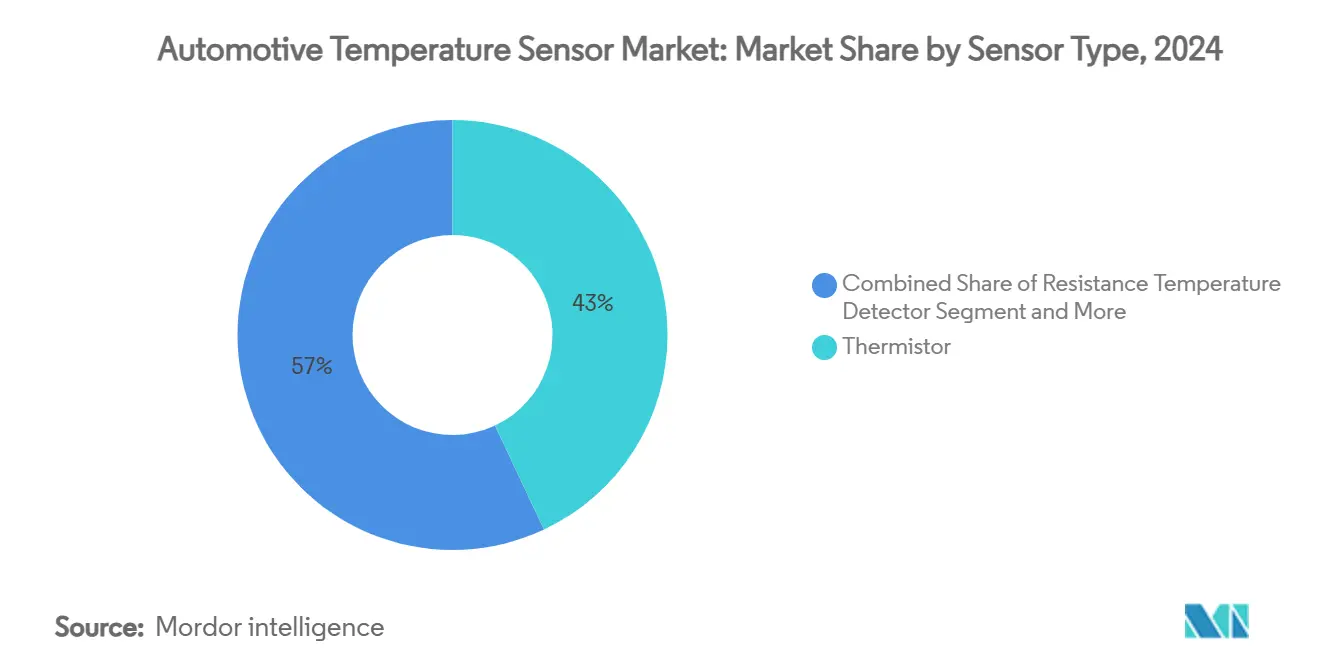
Note: Segment shares of all individual segments available upon report purchase
By Vehicle Type: Electric Propulsion Reshapes Demand Profiles
Passenger cars commanded 68.5% of 2024 revenue and remain the anchor for the automotive temperature sensor market. Sophisticated cabin comfort algorithms in premium trims exploit multiple sensing nodes to modulate micro-jets, seat heaters and zoned HVAC louvers. Continental’s factory trials reported a 15% uplift in overall equipment effectiveness after equipping production lines with additional thermal diagnostics — evidence that upstream manufacturing is also a consumption vector for sensors.
BEVs represent the fasting-growing cohort at a 10.3% CAGR. Every battery module clips thermistors to bus bars, embeds thin-film RTDs under cell tabs, and situates infrared die for non-contact monitoring—collectively doubling the automotive temperature sensor market size per vehicle relative to hybrids. Light commercial e-vans now integrate gas-generation detection sensors that relay early warning data to fleet dashboards, aligning thermal safety with asset-availability metrics. Two-wheelers in dense Asian cities add scale, leveraging compact, epoxy-sealed NTC beads resistant to vibration.
By Application: Electrification Pivots Spend Toward Battery Systems
Powertrain (ICE & hybrid) installations still represent 39.2% of total demand. Regulatory tightening around ammonia slip and particulate control necessitates dual-element exhaust probes that monitor both upstream and downstream of catalytic bricks. Hybrid architectures layer further complexity as control units balance oil, coolant and inverter temperature loops within millisecond windows.
Battery and electric drivetrain sensing is growing at an 11.7% CAGR, the quickest of any application. As solid-state cells arrive, algorithms will need an order of magnitude more spatial granularity, cementing this arena as the principal value generator for the automotive temperature sensor market. Chassis and safety electronics modestly expand with the rollout of brake-by-wire, while telematics modules integrate miniature die to oversee modem thermal throttling during 5G uploads.
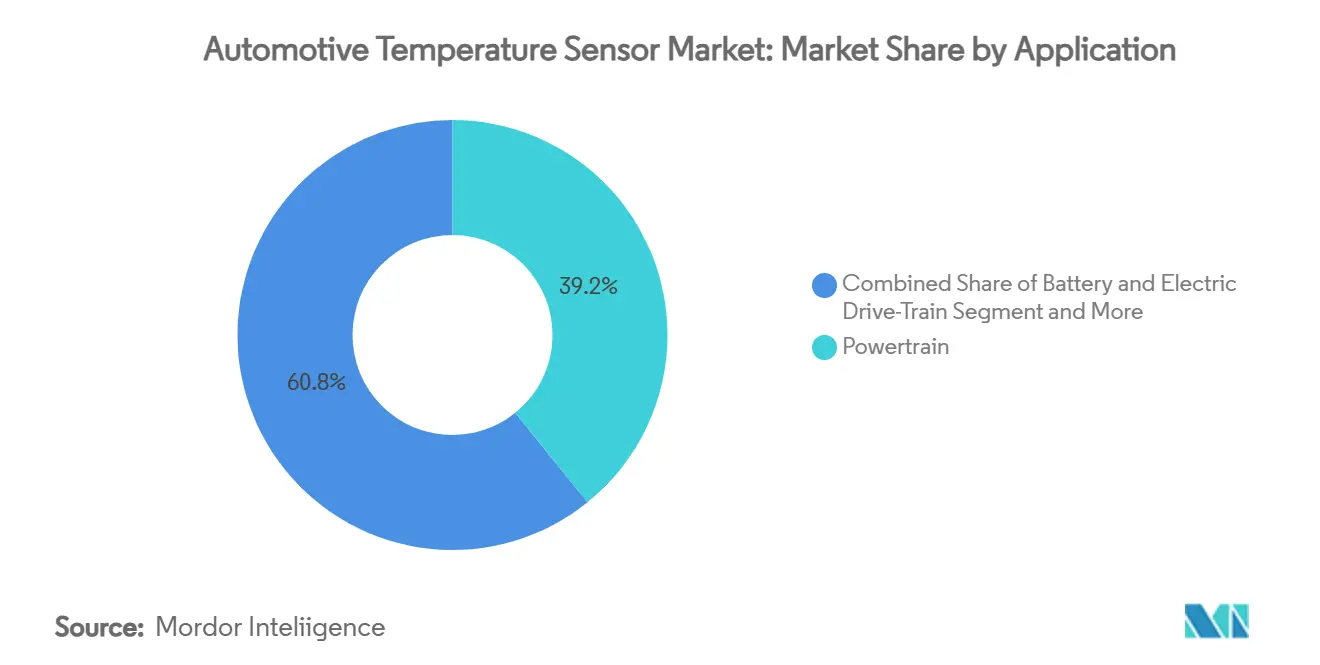
Note: Segment shares of all individual segments available upon report purchase
By Sales Channel: OEM Fitment Dominates, Aftermarket Picks Up Pace
Factory-installed sensors commanded 91.4% of shipments in 2024 because integration inside powertrain controllers demands early design alignment. Software-defined cars intensify this preference: OTA updates in 2027 model years already tweak thermal maps for inverters and battery packs, necessitating firmware-grade component traceability that only OEM supply chains guarantee.
Aftermarket volume rises at a 6.1% CAGR as global vehicle age nears 13 years and home mechanics source replacement coolant probes online. Standard Motor Products’ acquisition of a European cooling specialist positions it to supply calibrated kits that plug into existing wiring while communicating revised offset values to diagnostic dongles. This dynamic ensures the automotive temperature sensor market can monetise parts sales even as fleet electrification gradually reduces mechanical wear items
Geography Analysis
Asia-Pacific held 41.6% of automotive temperature sensor market share in 2024, reflecting its status as the world’s largest vehicle production hub. Chinese assemblers are localising advanced electronic content from 15% to 60% by 2030, funnelling additional design‐win opportunities to domestic thermistor and IC fabs. Japan and South Korea continue to invest heavily in solid-state battery pilots, which embed denser sensing arrays and lift the region’s contribution to automotive temperature sensor market size through the decade.
Europe ranks second, propelled by stringent EU7 rules that require real-time exhaust gas analytics and by a strong premium vehicle pipeline that emphasises in-cabin climate refinement. German OEMs spearhead zonal architecture rollouts; each new controller cluster carries its own ambient, board-edge, and MOSFET backside die, spreading demand across multiple product families. Suppliers located near the Rhine valley are setting up nickel-film RTD lines to navigate platinum scarcity, reinforcing regional self-sufficiency.
North America maintains a robust position thanks to high uptake of SiC-based drive modules in pickup trucks and SUVs that favour 800 V propulsion for trailer towing. Legislative incentives for local battery manufacturing are steering sensor sourcing toward vertically integrated US facilities. The Middle East, although small today, is forecast to clock a 9.2% CAGR as purpose-built autonomous mobility zones in Riyadh and Dubai standardise L4 shuttles loaded with redundant thermal nodes to safeguard compute clusters against desert heat. South America’s incremental growth is linked to flex-fuel powertrains that still need exhaust gas sensors alongside emergent electric buses operating in Brazilian megacities.
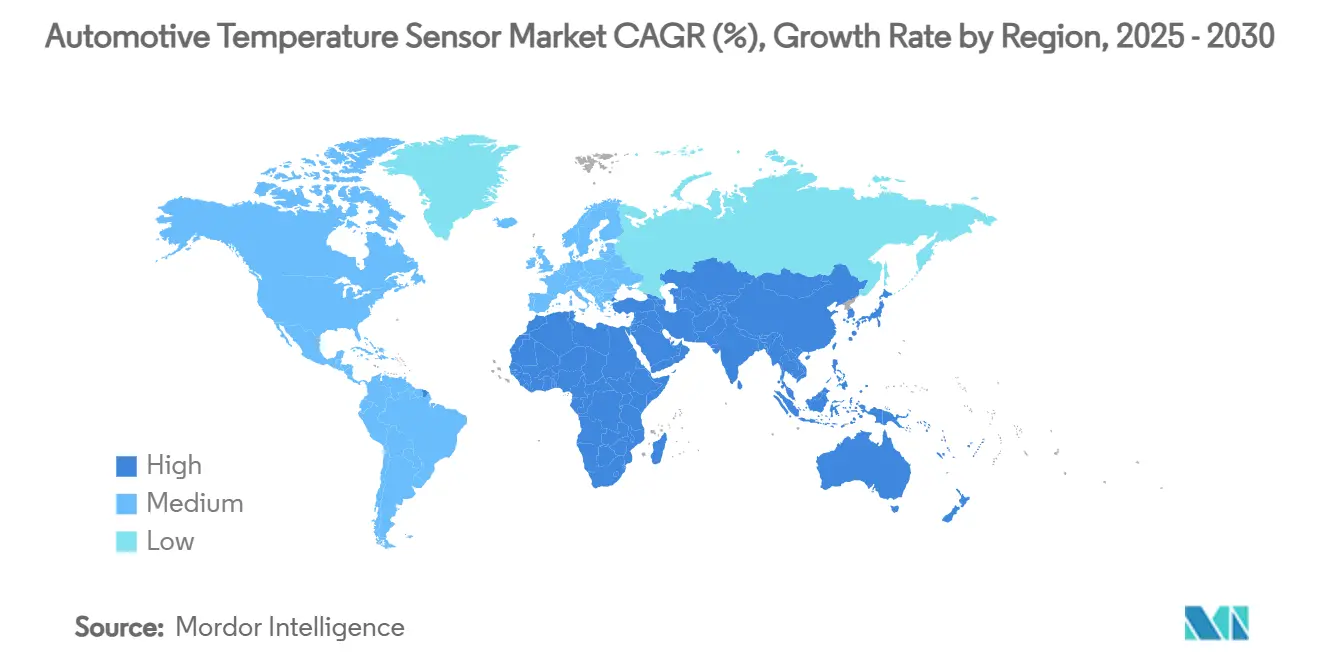
Competitive Landscape
The automotive temperature sensor market is moderately concentrated: the ten largest suppliers account for roughly 70% of revenue, balancing scale economies against pockets of niche expertise. Broadline semiconductor houses such as Texas Instruments, NXP and Onsemi leverage deep process technology to deliver highly integrated digital sensors that drop directly onto zonal controller PCBs. Meanwhile, specialists like Sensata and Amphenol focus on ruggedised inserts for exhaust manifolds and coolant jackets, safeguarding their franchise in high-temperature domains.
Strategic acquisitions illustrate the race for breadth. Spectris added Piezocryst to secure piezo-based probes suited for combustion optimisation, while Microchip absorbed VSI to marry networking SoCs with embedded sensing. MinebeaMitsumi’s tender for Shibaura expands its NTC footprint, reinforcing vertical integration from ceramic powders through finished beads. Packaging innovation is another battleground: Amkor’s optical ball-grid array with glass-on-sensor lids meets Grade 2 reliability while shrinking z-height for camera modules that also carry die to detect self-heating.
R&D spend is pivoting toward software-defined vehicles. Renesas collaborates with OEMs to embed thermal-aware schedulers inside zonal microcontrollers, dynamically allocating compute workloads away from hotspots. Littelfuse’s xEV portfolio targets inverter EMI with differential-pair sensor leads, guaranteeing signal fidelity during 400 A phase currents. As BEVs scale, collective bargaining for nickel film and ceramic substrates will intensify, but early movers with captive plating lines are positioned to shield margins.
Automotive Temperature Sensor Industry Leaders
-
Sensata Technologies Inc.
-
Robert Bosch GmbH
-
Continental AG
-
NXP Semiconductors N.V.
-
Amphenol Advanced Sensors
- *Disclaimer: Major Players sorted in no particular order
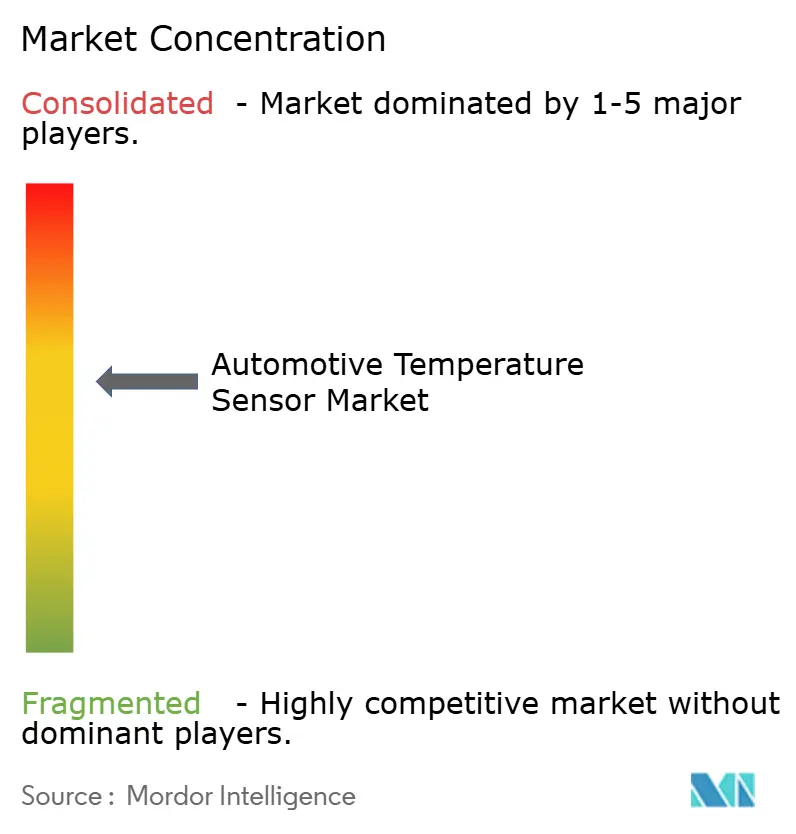
Recent Industry Developments
- May 2025: MinebeaMitsumi announced a tender offer for Shibaura Electronics at JPY 5,500 per share, enhancing synergies in automotive thermistors.
- May 2025: HGGaoli and LG commenced mass production of air-conditioning temperature sensors, projected to exceed USD 10 million in annual sales by H2 2025.
- May 2025: Amkor unveiled optical BGA packages with glass-on-sensor and glass-on-mold options, meeting AEC-Q100 Grade 2 reliability in high-temperature imaging modules.
- November 2024: Standard Motor Products completed the USD 390 million acquisition of Nissens Automotive, adding aftermarket cooling components to its North American and European reach.
Global Automotive Temperature Sensor Market Report Scope
Temperature sensor in the automotive industry effectively and accurately measure the temperature of a vehicle's oil, coolant, and air to ensure optimum performance. Automotive temperature sensors usually consist of either a thermistor, thermocouple, resistance temperature detector or an infrared device. Thermocouples are mainly used for measuring high temperatures (like exhaust gas temperatures), and infrared sensors are utilized where direct contact with the object being sensed is undesirable.
| Thermistor (NTC/PTC) |
| Resistance Temperature Detector (RTD) |
| Thermocouple |
| Semiconductor-Based IC Sensor |
| MEMS and Infra-Red Sensor |
| Passenger Cars |
| Light Commercial Vehicles |
| Heavy Commercial Vehicles |
| Two-Wheelers and Micro-Mobility |
| Powertrain (ICE, Hybrid) |
| Battery and Electric Drive-Train |
| Chassis and Safety Systems |
| Body and Comfort Electronics |
| Telematics and Connectivity Modules |
| OEM-Fitted |
| Aftermarket |
| North America | United States |
| Canada | |
| South America | Brazil |
| Argentina | |
| Europe | Germany |
| France | |
| Italy | |
| Spain | |
| United Kingdom | |
| Nordics | |
| Rest of Europe | |
| Middle East | Gulf Cooperation Council |
| Turkey | |
| Rest of Middle East | |
| Africa | South Africa |
| Nigeria | |
| Rest of Africa | |
| Asia-Pacific | China |
| Japan | |
| India | |
| South Korea | |
| ASEAN-5 | |
| Rest of Asia-Pacific |
| By Sensor Type | Thermistor (NTC/PTC) | |
| Resistance Temperature Detector (RTD) | ||
| Thermocouple | ||
| Semiconductor-Based IC Sensor | ||
| MEMS and Infra-Red Sensor | ||
| By Vehicle Type | Passenger Cars | |
| Light Commercial Vehicles | ||
| Heavy Commercial Vehicles | ||
| Two-Wheelers and Micro-Mobility | ||
| By Application | Powertrain (ICE, Hybrid) | |
| Battery and Electric Drive-Train | ||
| Chassis and Safety Systems | ||
| Body and Comfort Electronics | ||
| Telematics and Connectivity Modules | ||
| By Sales Channel | OEM-Fitted | |
| Aftermarket | ||
| By Geography | North America | United States |
| Canada | ||
| South America | Brazil | |
| Argentina | ||
| Europe | Germany | |
| France | ||
| Italy | ||
| Spain | ||
| United Kingdom | ||
| Nordics | ||
| Rest of Europe | ||
| Middle East | Gulf Cooperation Council | |
| Turkey | ||
| Rest of Middle East | ||
| Africa | South Africa | |
| Nigeria | ||
| Rest of Africa | ||
| Asia-Pacific | China | |
| Japan | ||
| India | ||
| South Korea | ||
| ASEAN-5 | ||
| Rest of Asia-Pacific | ||
Key Questions Answered in the Report
What is driving growth in the automotive temperature sensor market?
Electrification, zonal electronic architectures and stricter emission rules are increasing the number and precision of sensors required per vehicle, propelling a 6.79% CAGR to 2030.
How many temperature sensors does a modern BEV use?
A typical battery-electric car now incorporates close to 150 sensing points, nearly three times the count installed in a conventional combustion model.
Which sensor technology is expanding fastest?
Semiconductor-based temperature ICs are growing at an 8.8% CAGR through 2030 thanks to their digital accuracy and simple system integration.
Which region leads demand today?
Asia-Pacific holds 41.6% of automotive temperature sensor market share, leveraging its dominant vehicle production base and aggressive EV rollout.
How will solid-state batteries influence sensor demand?
Solid-state packs operate within a narrower thermal window, requiring 40%–60% more sensors per module to maintain safety and performance, supporting long-term market growth.
What impact does SiC technology have on temperature sensing?
SiC inverters run at temperatures up to 600 °C, necessitating additional high-accuracy probes to protect power electronics and enabling faster 800 V charging architectures
Page last updated on:
